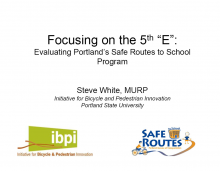We are pleased to announce an exciting new alliance between Active Living Research and GP RED to co-host and coordinate...
Focusing on the 5th "E": Evaluating Portland's Safe Routes to School Program

Presentation at the 2010 Active Living Research Annual Conference
Background:
At its core, the national model Safe Routes to School (SRTS) is concerned with the Active Living Research 2010 Conference’s central theme of creating active living environments to address the nationwide childhood obesity epidemic. The primary goal of the SRTS program is to increase the physical activity rates of school children by reversing the dramatic shift in school commute modes from walking and biking to driving. This shift has deprived many children of an opportunity for daily physical exercise and has contributed to significant increases in childhood obesity rates. The SRTS program seeks to accomplish this through a comprehensive “4E” behavior change strategy comprised of education, encouragement, enforcement, and engineering programs and projects that create active living-supportive environments for all members of the community including children.
Federal funding for SRTS programs based on the “4E” model became available in late 2005 with the passage of the current federal transportation bill, the Safe, Accountable, Flexible, Efficient Transportation Equity Act: A Legacy for Users (SAFETEA-LU). Because of the newness of the program and the novelty of school commute behavior as a distinct research subject, federal program administrators also required a fifth “E”, evaluation, as part of the program, requiring that programs receiving federal funding administer a standardized survey and hand-raising tally every spring and fall. These evaluation tools ask students and parents about mode choice, travel time and distance, issues and concerns affecting mode choice, and general attitudes about the health, safety, and enjoyment of walking and biking.
The surveys are providing communities with data sets that can help them better understand and shape school commute behavior. However, no studies employing the results of these widely used surveys have yet been published. As a result, program administrators strapped for time and resources currently lack examples of survey-based evaluation strategies that would help them make use of their survey data when considering changes to their programs to make them more effective tools to promote walking and biking to school.
Objectives:
The primary objective of this research project is provide such an example by using survey and other data from the City of Portland, Oregon to inform program evaluation and improvement. It identifies what the surveys tell us about why Portland’s students do or don’t actively commute to school, and considers additional data sources to augment the surveys and further inform the program administrators’ understanding of school commute mode choices and evaluation techniques. A secondary objective is to place the lessons from Portland’s experience in the context of the growing body of academic research on school commute behavior in order to help inform our broader understanding of this subset of travel behavior.
Methods:
This project is based on both cross-sectional and longitudinal analyses of the SRTS student hand-raising tally and parent survey data that the City of Portland Bureau of Transportation began compiling for 25 elementary schools in spring 2007. Parent surveys were mailed out to every student’s household every spring and fall through spring 2009, averaging a 17% response rate, and producing 7,300 usable surveys. Hand tallies were similarly conducted on 2-3 days in one week every spring and fall in every classroom, and averaged a completion rate of over 90%, resulting in 1,570 classroom tallies. This data, along with GIS-based data for measuring urban form variables, neighborhood-level census data, and program-specific data gathered from program administrators is currently being used to develop regression models for identifying variables that predict active mode choice, and to help consider the utility of different types of supplementary data for analyzing SRTS programs.
Results:
Preliminary results from an analysis of the survey data indicate that the primary variable influencing whether a child walks or bikes to school is distance, but that parental perceptions of the health and enjoyment of walking and biking also play a role. In addition, the overall increase in active mode shares experienced at the 25 schools in aggregate since program inception is also positively correlated with parental perceptions of their schools’ encouragement of walking and biking. Of the program-specific variables tested, the presence of experienced volunteers on a school’s SRTS team had the largest impact on positive changes in active mode shares, while engineering changes had the least impact.
Conclusions:
These preliminary results suggest that jurisdictions can most influence school commute mode choices by making sure that schools and residential areas are sited in close proximity to each other. In addition, encouragement and educational programs such as SRTS appear to be effective tools in increasing active mode shares for school commutes. Finally, the relatively strong influence of experienced volunteers on program outcomes, especially with respect to engineering, suggest that greater proportions of the SRTS resources should be directed to developing volunteer capacity at participating schools.
Support:
The City of Portland Bureau of Transportation provided funding for this study.
STAY UP TO DATE
RECENTLY ADDED TOOLS & RESOURCES
MOVE! A BLOG ABOUT ACTIVE LIVING
The "Active Living Conference" aims to break down research and practice silos and...







